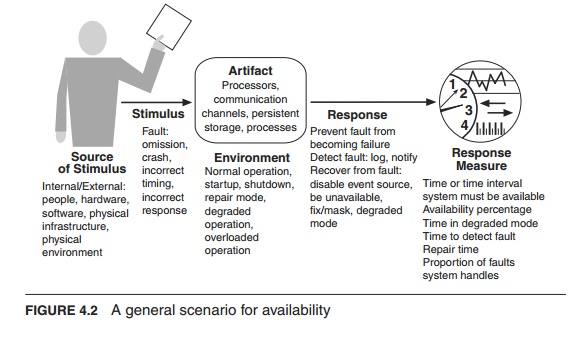Chapter: Software Architectures : Introduction and Architectural Drivers
Specifying Quality Attribute Requirements
Specifying Quality Attribute Requirements
A quality attribute requirement
should be unambiguous and testable. We use a common form to specify all quality
attribute requirements. This has the advantage of emphasizing the commonalities
among all quality attributes. It has the disadvantage of occasionally being a force-fit for some aspects
of quality attributes.
Our
common form for quality attribute expression has these parts:
■■ Stimulus. We use the term “stimulus” to
describe an event arriving at the system. The stimulus can be an
event to the performance community, a user operation to the usability
community, or an attack to the security community. We use the same term to
describe a motivating action for developmental qualities. Thus, a stimulus for modifiability
is a request for a modification; a stimulus for testability is the completion
of a phase of development.
■■ Stimulus source. A stimulus must have a source—it
must come from some-where.
The source of the stimulus may affect how it is treated by the system. A request from a trusted user
will not undergo the same scrutiny as a request by an untrusted user.
■■ Response. How the system should respond to
the stimulus must also be specified. The response consists
of the responsibilities that the system (for runtime qualities) or the
developers (for development-time qualities) should perform in response to the
stimulus. For example, in a performance scenario, an event arrives (the
stimulus) and the system should process that event and generate a response. In
a modifiability scenario, a request for a modification arrives (the stimulus)
and the developers should implement
the modification—without side effects—and then test and deploy the
modification.
■■ Response measure. Determining whether a response is
satisfactory— whether the requirement is
satisfied—is enabled by providing a response measure. For performance this
could be a measure of latency or throughput; for modifiability it could be the
labor or wall clock time required to make, test, and deploy the modification.
These
four characteristics of a scenario are the heart of our quality attribute
specifications. But there are two more characteristics that are important:
environment and artifact.
■■ Environment. The environment of a requirement is the set of
circumstances in which the scenario takes place.
The environment acts as a qualifier on the stimulus. For example, a request for
a modification that arrives after the code has been frozen for a release may be
treated differently than one that arrives before the freeze. A failure that is
the fifth successive failure of a component may be treated differently than the
first failure of that component.
■■ Artifact. Finally, the artifact is the
portion of the system to which the requirement applies. Frequently
this is the entire system, but occasionally specific portions of the system may be called out. A
failure in a data store may be treated differently than a failure in the
metadata store. Modifications to the user interface may have faster response
times than modifications to the middleware.
To
summarize how we specify quality attribute requirements, we capture them
formally as six-part scenarios. While it is common to omit one or more of these
six parts, particularly in the early stages of thinking about quality
attributes, knowing that all parts are there forces the architect to consider
whether each part is relevant.
In
summary, here are the six parts:
1.
Source of stimulus. This is some entity (a human, a
computer system, or any other actuator) that generated
the stimulus.
2.
Stimulus. The stimulus is a condition that
requires a response when it ar-rives at a system.
3.
Environment. The stimulus occurs under certain
conditions. The system may be in an overload condition or
in normal operation, or some other rele-vant state. For many systems, “normal” operation can refer
to one of a num-ber
of modes. For these kinds of systems, the environment should specify in which
mode the system is executing.
4.
Artifact. Some artifact is stimulated. This
may be a collection of systems, the whole system, or some piece or
pieces of it.
5.
Response. The response is the activity
undertaken as the result of the arrival of the stimulus.
6.
Response measure. When the response occurs, it
should be measurable in some fashion so that the
requirement can be tested.
We
distinguish general quality attribute scenarios
(which we call “general scenarios” for short)—those that are system independent
and can, potentially, pertain to any system—from concrete quality attribute scenarios
(concrete scenarios)—those that are specific to
the particular system under consideration.
We can characterize quality
attributes as a collection of general scenarios. Of course, to translate these
generic attribute characterizations into requirements for a particular system,
the general scenarios need to be made system specific. Detailed examples of
these scenarios will be given in Chapters 5–11. Figure 4.1 shows the parts of a
quality attribute scenario that we have just discussed. Figure 4.2 shows an example of a
general scenario, in this case for availability.


Related Topics